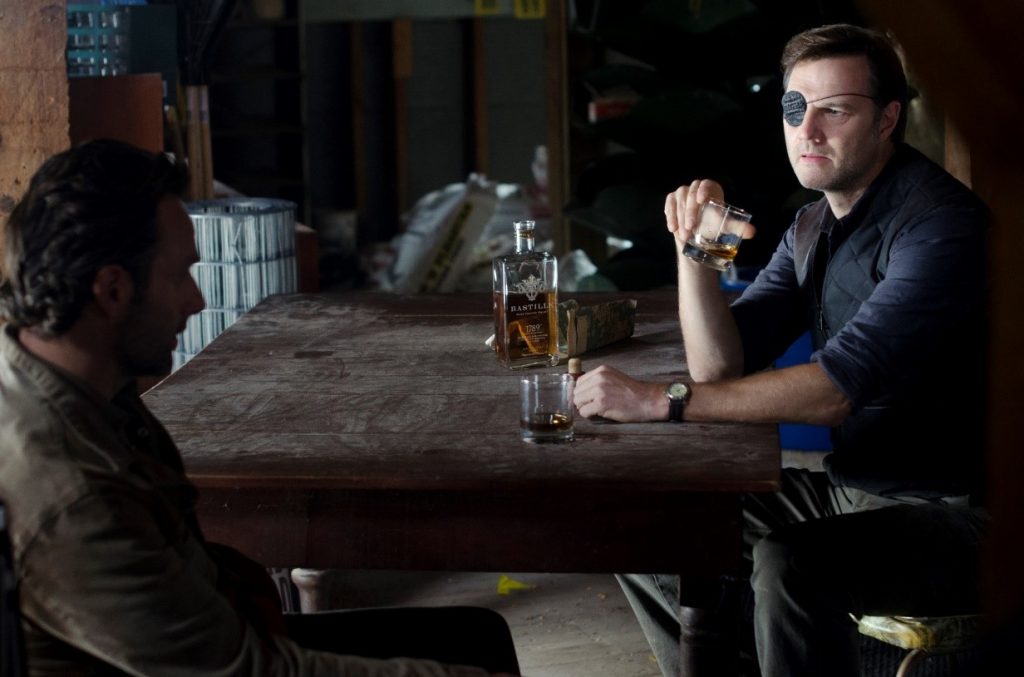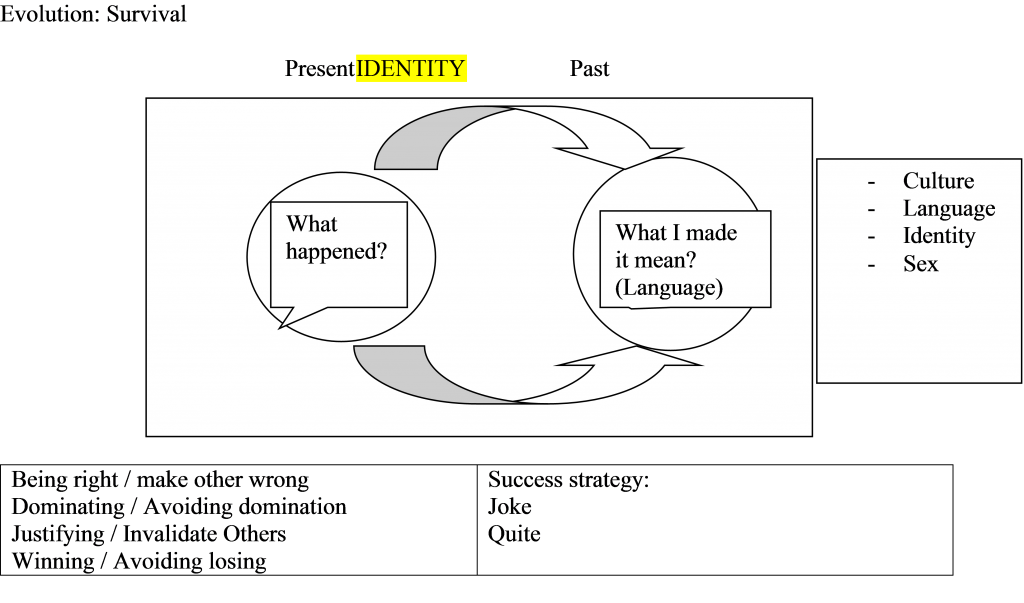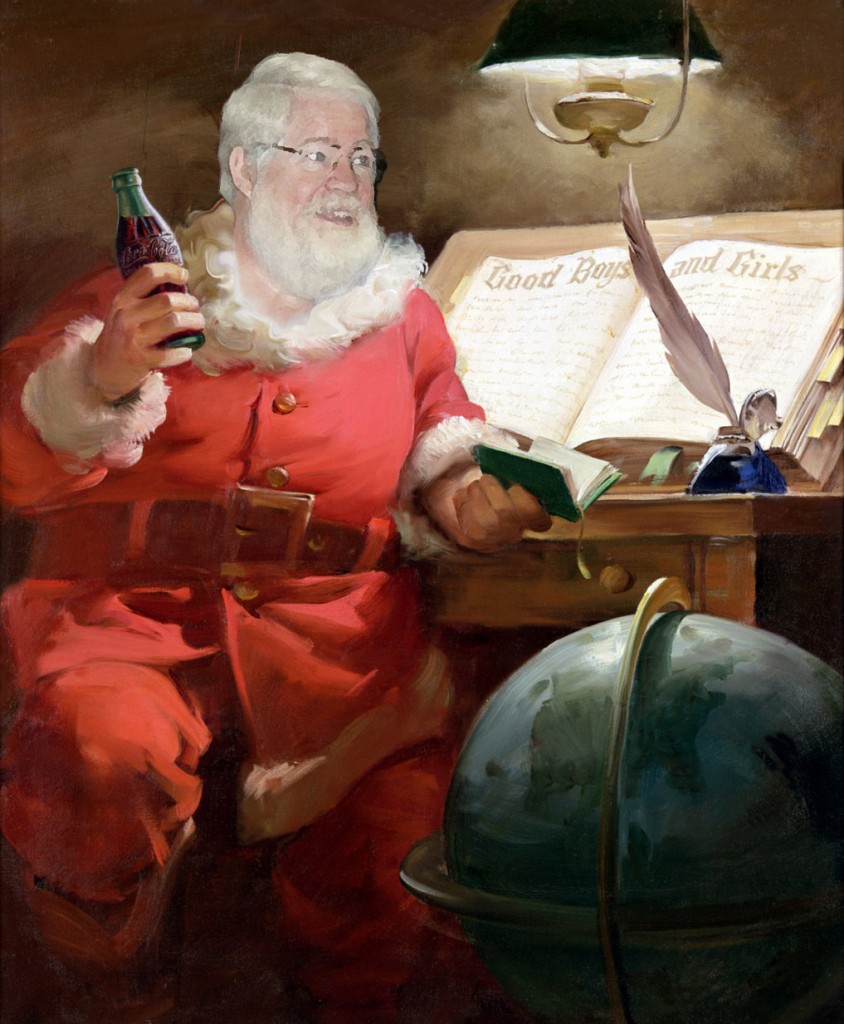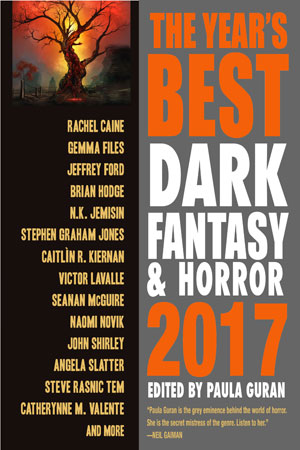By Ron S. Friedman: How to use evolution, consciousness and behavior science to create a three-dimensional villain that can believably confront the hero. Eliminate the BS factor and the pitfalls of a simplistic moustache-twirling bad guy.

By the way, that’s not me.
This blog post is based on a 50-minute visual presentation I gave at Calgary Comic and Entertainment Expo and When Words Collide festival for readers and writers in 2016.
###
Let’s plunge right into our first example:

This image shows a scene from The Walking Dead TV series. The two people above are the protagonist, Rick Grimes, and The Governor, his adversary during multiple seasons.
Both Rick and The Governor are natural leaders. Each of them leads a group of people who are trying to survive in the midst of a zombie apocalypse. Both are motivated by the same goals—to ensure the survival of the people who are dependent on them. Both want to protect their families and friends. Both are willing to do horrible things, overcome moral dilemmas, make hard choices, fight and even kill to achieve these noble goals.
These two characters are almost identical. Not much difference, eh?
So, why Rick is the hero, and The Governor the villain?
There is one profound aspect that’s set them apart. The Governor, to increase the survival chance of his people, is willing to prey on the weak. He will ambush, rob and kill people outside his group to ensure a supply of ammunition, medicine and other valuables critical for survival. This is a step Rick will not endorse, at least not as his first choice.
###
Type of conflicts:
On my way to deliver the Villains and Conflict presentation at Calgary Comic and Entertainment Expo, my neighbor stopped me for a chat. I told her I was about to give a presentation on Conflicts.
“Wow! That’s my favorite topic,” she said, smiling.
“Conflicts?” I scratched the back of my head. “Really?”
“Yes, conflict resolution. Love it.”
“Oh no, no, no.” I waved my hands and laughed. “You got me wrong. I’m a writer. My speech has nothing to do with conflict resolution. On the contrary, I will talk on how to create conflicts. I want conflicts.”
Conflict are essential plot device. Conflicts are the main drive that moves your story forward. Without them, your story will be as dull and boring as a TPS report.
Granted, there’re many types of conflicts, traditionally covered in many creative writing classes. The major conflict types include: Character vs. character, character vs. self; character vs. society, society vs. society, character vs. nature, character vs. technology, character vs. supernatural and character vs. destiny.
We’ll focus primarily on character vs. character conflicts, which is, in my humble opinion, the most interesting type. And besides, isn’t that what villains are all about?
###
How not to write villains:
Let’s start with the bad example—the cliché.
Here are some essential steps you can undertake, assuming you want to create an awful villain and ensure your story is rejected by publishers and mocked by readers.
Step one: Make sure your villain dresses like a villain, talks like a villain, and look like a cliché villain. Your favorite color is black, and yes, a moustache is a crucial fashion statement.
Step two: Make certain your villain acts villainously with no obvious motivation. Do evil just for the sake of evilness. Also, you want your villain to be flat and with no history.
Step three: A bonus. Include a weak female character who is only there to be kidnapped by the villain and saved by the hero, and be grateful for that. And yes, a powerful screaming voice is a plus.
If this can’t ensure a rejection, I don’t know what does.
Proviso: A cliché villain may work in some rare cases, such as in a parody, as was seen in the latest do-gooder Dudley Do-Right movie.
###
A good character vs. character conflict:
My theory on how to create an appealing villain and a grabbing character vs. character conflict could be summarized in one sentence: Conflict occurs due to a disagreement over fictional realities.
To understand that, we’ll start from the beginning. And when I say beginning, I mean roll back the clock the appearance of life on planet Earth, and the evolution of the human brain.
###
Life’s most basic function:
What is life’s most basic function?
It doesn’t matter what kind of organism you are. You could be fungus, bacteria, plant, zebra in the savannah, a chimpanzee in the jungle or humans in the office. Whenever I ask this question during conventions, the answer I almost always get is:

Let me repeat that. Life’s most basic function is to survive. Whatever we do is directly or indirectly derived from our wish to increase our survival chances, or the survival of the people close to us or our species.
Sometimes someone may say that life’s most basic function is procreation. That may be true. But if you think about it, procreation is crucial for the survival of the species, hence, survival.
We eat to survive. We breath to survive. We go to the doctor to survive. We go to work to earn money, to buy food, shelter and healthcare to survive. We engage in office politics to survive in the office. We study to increase our chance to find better opportunities to earn more so we could … do better in this survival stuff.
Hold on to that thought.
We’ll go back to survival. I promise. But first I want to review the evolution of consciousness and the human brain. Then, I’ll tied that to our survival instinct to create the survival model—the perfect villain machine.
###
The evolution of consciousness:
- Level one: React to light or heat -> One dimensional. Flowers have consciousness level 1. They open themselves to the sun, and follow it as it moves along the sky.
- Level two: Space. Maneuver and interact in a 3D space. Most animals are at this level. Animals such as fish, insects and reptiles. Today’s most advanced autonomous robots and drones are at this level.
- Level three: Social. Animals that can socially interact with other animals. Coordinate. Hierarchy. Birds and Mammals. Wolf, Chimpanzees and Dolphins are examples social animals of level 2 consciousness. Now, it is true that some insects, such as ants or bees do have social structure, but it’s not as flexible as a wolfpack or a human society which can lean new tricks and quickly adopt to new conditions. Ants can cooperate in large number, but their cooperation is derived from their genetics, and not from their intellect. To change their social behaviour, ant colonies will have to change genetically over many generations. Worker ants are incapable of deposing their queen and establishing a communist dictatorship or a democracy in its place.
- Level four: Ability to simulate the future. Frontal cortex.
We, Homo Sapiens human, have this extra brain mass in the front of our head. A part called the frontal lobe, or the frontal cortex. We, humans, can simulate the future and act upon it. We can build pyramids designed to survive for thousands of years. We can plan our career and our retirement. We can plan projects, such as the space program, that may take decades to implement. And we can worry about climate change in the next century.
Now, it is true that it appears that some animals, such as squirrels who collect nuts for the winter, seems to think about the future. But like the ants, this behavior is derived from genetics and not from drawing intelligent conclusions.
Non-human mammals can only plan a few minutes into the future. Coordinate a hunt or other short-term endeavors. If you tell your cat that you lost your job, and you won’t be able to pay the mortgage next month, it won’t even register.
Yes, my dear readers. We, humans have great powers to predict the future. Jedi Powers.
Conclusion: To avoid the pitfalls of a flat villain, give him or her a level four consciousness. The ability to create a model of the world, calculate how it will evolve in order to achieve a goal.
###
More about creating a model of the world – The cognitive revolution
We are almost ready to dive into the survival model and create the perfect villains. All that is left is to discuss the cognitive revolution. The next evolutionary step that had allowed Homo Sapiens to become the dominant animal of planet Earth.
Before the cognitive revolution, early human could only cooperate in small bands of no more than a few dozen individuals. In that respect, we were no different than apes, wolves and other social animals. Cooperation was limited to personal connections. The leaders and the members of the band or the tribe knew each other on an intimate basis, and using those personal connections the groups was able to function, cooperate, plan and quickly adapt to changing conditions.
There was no common story, an ideology or a unified world view that would allow millions of strangers to cooperate to achieve a common goal. Each small band had its own goals.
About 120,000 years ago, we, Homo Sapiens, had tried to leave Africa. We were repealed by the Neanderthals.
Then, between 30,000 and 70,000 years ago, something changed. Suddenly, we were able to cooperate in large numbers, and in a relatively short timeframe we managed to take over the world.
What happened?

The ivory statue above is called the Lion-man of the Hohlenstein-Stadel. It was found in Germany, and it’s dated to 35,000 – 40,000 years ago.
Have you noticed something weird about it?
You are absolutely right. The statue has the body of a man and the head of a lion. The truth is that such an animal does NOT exist in nature. Trust me. There really is no animal in nature with a human body and a lion head.
What?
A cave man 35,000-40,000 years ago created a statue of an animal that does not exist?
How is this possible?
Welcome to the cognitive revolution. Fictional story had just become a reality.
Scientists are not sure what happened. One theory suggests that a minor evolutionary change to the human brain had allowed better communication between the left and the right parts.
Regardless, we, Homo Sapiens, heroes and villains, now have the ability to create imaginary stories, and attract others to believe in them.
These fictional tales gave us a huge evolutionary advantage over other human spices and other animals. They allowed us to cooperate in large numbers toward a common goal, giving us the evolutionary advantage that other Human species didn’t have.
Examples to imagined realities that allow large-scale cooperation includes: Corporations, national borders, countries, money, religions, ideologies etc.
I have to say it once more. Now, millions of people who don’t know each other, are willing to work together and even follow a charismatic leader and wage war.
Splendid. Imagined reality had made Homo Sapiens inherited the Earth.
How is this knowledge be used to create reliable villains?
###
The Survival Model—the plot thickens
If you want to take only one thing from this essay, make it the survival model.
In the survival model we combine what we’d learned so far about Survival, Consciousness and the Cognitive Revolution.
- All humans, including villains, want themselves or people close to them, to survive. They will act to increase their survival chances.
- All humans, including villains, have intelligent consciousness that provides them the ability to create a model of the world, calculate how it will evolve and act in order to survive.
- That model of the world can be fictional.
Here is a diagram of the survival model.

An event happens, (represented by the “What happened?” the circle on the left). That event is interpreted differently by different people, based on their culture, language, identity, sex and other factors. (represented by the “What I made it mean” the circle on the right).

Different people can see the exact same image and interpret it differently. The person with the pessimistic world view may say that the picture above is a glass half empty. Another person may say it’s half full. And a third person may say that the glass is fully filled, half with water and half with air.

O.J. Simpson’s trial and verdict is another example where different people with different perspectives interpreted the same event differently. Some people sympathized with the victim and the police, while others sympathized with the defendant.
###
The good villain and the bad villain.
The key for creating a good villain is to make him or her make choice like a human, based on the survival model. Don’t create a villain who acts villainously for no reason but to fulfill his antagonist role. Make the villain a real person with real human motives, real needs and real dilemma.
A good villain sees himself as a hero. A good villain only wants to survive and to protect his world. The only reason he is a villain is because he sees the world differently, and he make choices to survive based on his unique world view that results in a conflict with the protagonist.
I’m a big J. R. R. Tolkien fan. Tolkien invented the epic fantasy genre. I love Lord of the Rings.
Having said that, I, personally believe Saruman is a better villain than the main antagonist, Sauron.
I couldn’t understand Sauron’s motivation. Yes, he was evil. He was powerful and badass. He wanted to kill the Hobbits, destroy Minas Tirith and take over the world. But why?
I could relate much better to Saruman. I could understand him and his motives. Who knows, in his shoes, I may have acted in the same way as he did. The way he saw the world made him believe that Middle Earth had no chance of winning a war with Sauron. From his perspective, joining Sauron was the wise choice. The only logical choice to survive. As an act of friendship and kindness (in Saruman’s perspective) he even offered Gandalf to join him.
The conflict with Gandalf only occurred because Gandalf saw reality differently. Gandalf believed a war with Sauron is not a lost cause.
Wouldn’t you agree that Saruman is a much better villain than Sauron?
###
A few examples:

Erik Lehnsherr, known by his villain name Magneto, is the main antagonist in the X-men universe. As a child, he saw his family being exterminated in the Holocaust because the Nazis thought Jews were genetically inferior.
Magneto sees today’s world as the reflection of his childhood. In the modern world, he sees mutants being marked and targeted by genetic discrimination. He hears that some normal people view mutants as a threat, and they propose to act against mutants. Based on his Holocaust survivor viewpoints, he believes that all the non-mutants are a threat, and he will act to destroy this treat in order to ensure the survival of his fellow mutants.
Isn’t Magneto a much better villain than that flat alternative who just want to kill normal people for no apparent reason but evilness?

The Borg queen is the Federation’s most malevolent adversary in the Galaxy. The queen is not a traditional leader like in many human societies. She is the face, or the representative of the Borg Collective, which is structured in a similar principle of the internet, with no centralized control.
The Borg are not evil just for the sake of being evil. The Borg Collective see themselves as the most advanced form of civilization in the Galaxy. They believe that the best strategy to ensure the long-term survival of the Collective is by assimilating other species into the collective and adding their technological and biological distinctiveness to their own.
Again, the Borg Collective see the universe in a certain way, and act to increase its own survival chances.
###
When Evil Doesn’t make sense.

I really liked Guardian of the Galaxy. A vivid movie, great dynamics between the characters and just the right amount of humor.
Having said that, I don’t really understand the antagonist’s motivation. Yes, it was mentioned in the movie that Ronan the Accuser had an old hatred toward the Xandarians. But as a viewer, it didn’t sink. We didn’t see the ancient wars. Maybe the Xandarians had inflicted terror and horror upon the Kree. Maybe it only occurred in Ronan’s mind. Regardless, as a viewer I didn’t believe it.
It wasn’t natural for me to understand why Ronan took the suicidal risk and use the deadly Infinity Stone. Why did he defy Thanos, the most powerful entity in the galaxy? It goes against the survival model.
The movie itself was fun and entertaining. But wouldn’t it be even better had the motivation behind the villain’s actions been clearer and more humanlike?
###
The crazy ones.
In the initial DC Comics the Joker was crazy. A nut case. Batman and the readers could not explain why he acted the way he did. It looked like he did so just for the sake of being an interesting Batman’s antagonist. It’s not like being cracked had helped the Joker to achieve a goal that could increase his or his loved ones’ survival rate.
This deficiency had been noticed by the readers and the writers. In later Comics issues and in Christopher Nolan’s The Dark Knight movie, the Jokers behavior was explained. The Joker saw himself as an agent of chaos. He truly believed that by spreading chaos, society would improve itself. (a.k.a. increased its long-term survival chance.) This motivation is similar to the Shadows’ motivation in the Babylon 5 series. Bringing the villain’s motivation back to an explanation that fits the survival (of society) model.
The new Joker is a much better villain. Wouldn’t you agree?
###
Real live villain vs. the unthinkable out of this world villain.
A recent survey tried to list and rank all the villains in the Harry Potter series. The top two villains turned out to be Voldemort and Dolores Umbridge.
Umbridge is a school teacher, a senior undersecretary which assumed the position of a school principal. She has a tendency to speak to people she feels are her lessers in a very condescending tone. And on occasions, she buses her authority to gain more control.
Voldemort is basically a Wizard Hitler. He is powerful. He is a racist who hates and despises anyone who is not a pure-blood wizard. He kills his opponents, he tried, and in one occasion succeeded, to kill Harry Potter. He even kills his close servants when it gives him an edge, no matter how minor. Remember Professor Snape?
Who do you think is the number one villain in the series? The school principal who abuses her authority, or the mass murdered Wizard Hitler?
You guested it right. Only 11% of the people who participated in the survey thought Voldemort is the main evil, while 56% of the survey participants gave that honor to Umbridge.
Why is that?
Clearly, Voldemort is much more dangerous and he causes significantly more pain and damage. However, he isn’t real. The series young adult readers had ever met a Wizard Hitler in their life. While a teacher who abuses her authority is definitely something Harry Potter’s readership can relate to.
###
More tricks for your arsenal:
The last tools I can provide that can help you create different world views, and better villains and conflicts are:
Free Will vs. Determinism. Causality – cause and effect
Philosophers and scientist are debating how the human mind works. On one hand we have free will, where we assume each person can decide her own action and fate. On the other, we have causality, cause and effect. The assumption that whenever we act, it’s only because something forced us to react.
These two philosophies are represented in the Matrix movie series, where the Oracle is the agent of free will, and the Merovingian (The Frenchman) represents causality.
Do we have the free will to act and change our fortune? Wars had been fought over this question. The most famous is Martin Luther’s reformation which eventually led to the schism between the Catholic Church and the Protestants and to the devastating Thirty Years War. What was the root cause for these millions of deaths? A disagreement whether a person can pay for forgiveness thus buy a spot in heaven.
Scientists don’t have an answer if we have free will or not. But our legal system is based on the assumption that we do. Without free will, no one can be accountable for anything.
Causality – cause and effect is an excellent way to generate disagreement among characters.
This philosophy exists for more than 2500 years, since ancient Greece. It’s embedded in our thought process since childhood.
What is the beauty of cause and effect in term of creating villains? People will NEVER agree what was the initial cause that started a cause and effect chain of events. Someone can always find a cause for the cause … I’m originally from Israel. The Israeli-Palestinian conflict can be summarized as a disagreement of what was the cause of the conflict, and whether the clock should be turned back to 1967 (The Six Day War), 1948, 1947, 1917, 1897, 800 AD, 960 BCE and some people even go as far back as 1800BCE. But frankly, it all started with a Big Bang nearly fourteen billion years ago.
Disagreement over a root cause is a way to create conflicts and better motivation behind villains.
###
I hope the survival model and the science behind the way the human mind words, can help you create real, multi-dimensional villains and more reliable conflicts.

Ron S. Friedman
RON S. FRIEDMAN is a Best Short Fiction finalist in the 2016 Aurora Awards, Canada’s premier Science-Fiction and Fantasy awards. Ron’s short stories have appeared in Galaxy’s Edge, Daily Science Fiction, and in other magazines and anthologies. Ron co-edited two anthologies and he received ten Honorable Mentions in Writers of the Future Contest.
Ron is a member of SFWA and SFCanada.
In March 2017, Ron is releasing his Short Stories Series Escape Velocity, which will include many of his Honorable Mentions stories.
For more information, please visit: https://ronsfriedman.wordpress.com/

































